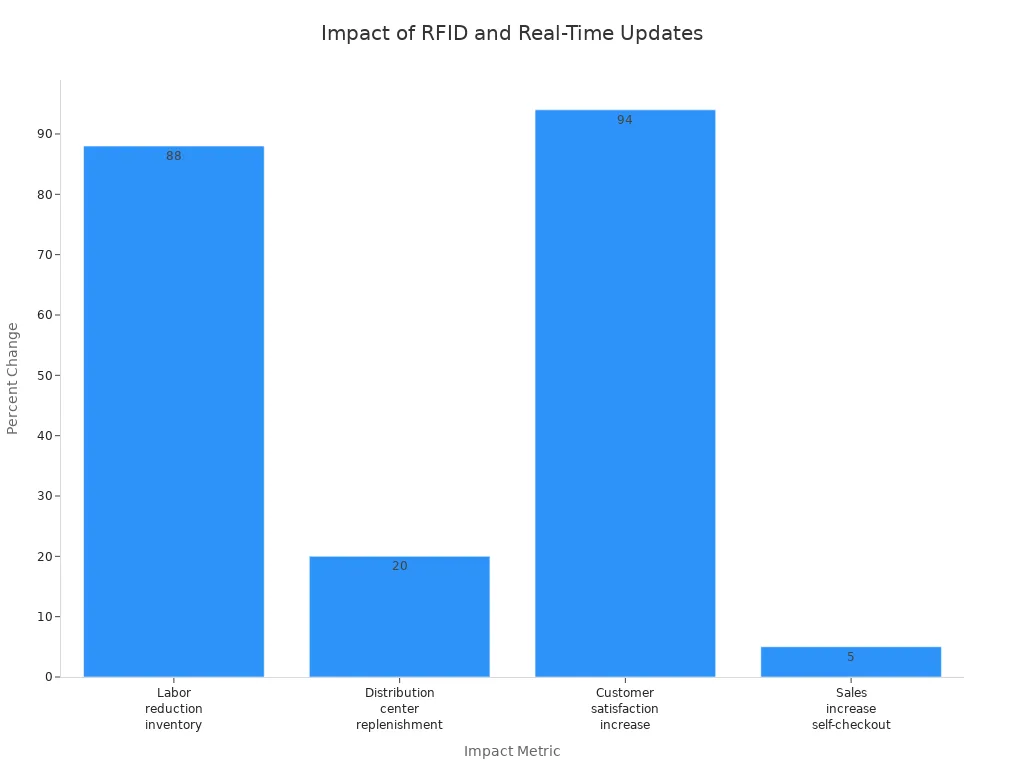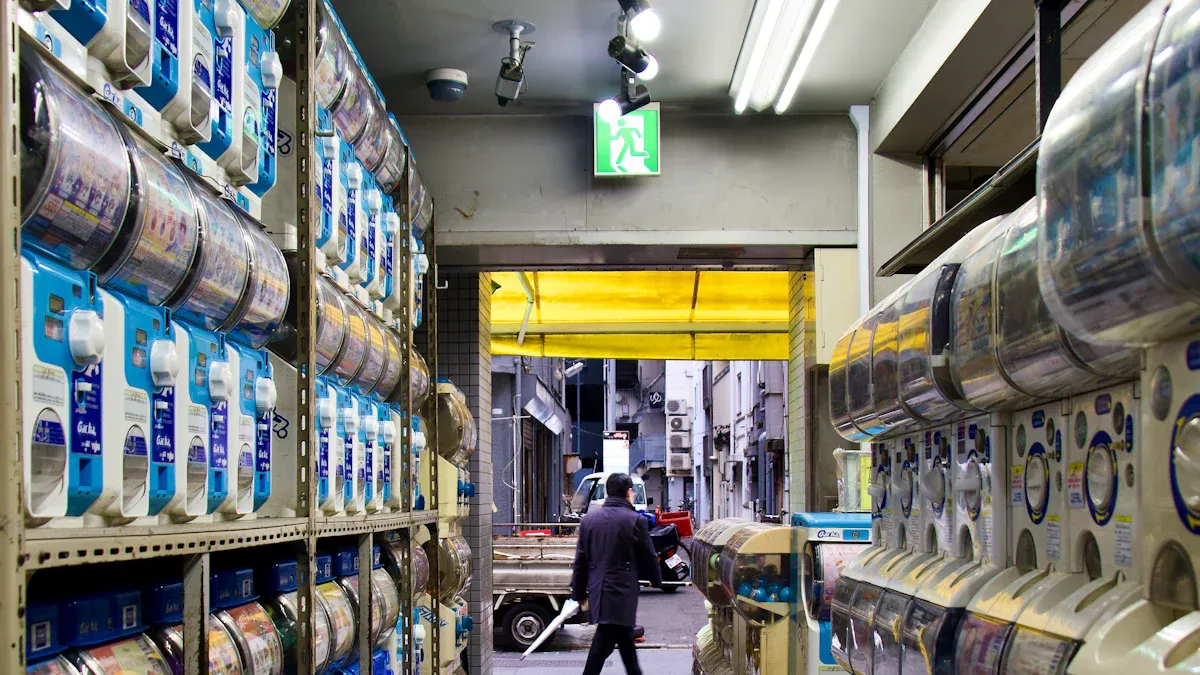
H&M store redefines in-store efficiency with digital price tags that harness RFID and Electronic Shelf Labels. The ESL Gateway AP and ESL Price Tag work together to provide real-time price accuracy, supporting Esl Retail strategies. Store associates use RFID-enabled tags to track inventory with one-meter accuracy and deliver instant product data. These innovations drive measurable results:
| Impact Metric | Measurable Result |
|---|---|
| Labor reduction for inventory cycle counts | 88% reduction compared to barcode scanning |
| Improvement in distribution center replenishment | 20% improvement |
| Increase in customer satisfaction (self-checkout) | 94% increase |
| Sales increase attributed to frictionless self-checkout | 5% increase |

Digital Price Tags in H&M Store: Technology and Adoption
RFID Integration with Digital Price Tags
Real-Time Inventory and Price Synchronization
H&M store leverages RFID technology with digital shelf labels to achieve real-time inventory and price synchronization. RFID tagging of individual garments provides instant insight into stock levels and enables sophisticated management of inventory. Automation reduces manual errors and improves accuracy. Store associates can process checkouts and returns instantly, which speeds up operations and enhances the customer experience.
- RFID integration allows precise tracking of merchandise from warehouse to sales floor.
- Digital shelf labels display real-time product and promotional information.
- Automated replenishment triggers help maintain optimal inventory levels and reduce costs.
- Smart shelves collect data on stock levels and shopping patterns, supporting intelligent inventory systems that forecast sales trends and adjust stock accordingly.
Retailers benefit from these improvements through reduced overstock and out-of-stock situations. Dynamic pricing and rapid floor replenishment streamline store operations, contributing to a frictionless shopping experience and greater operational agility.
Linking In-Store and Online Data
Digital price tags and electronic shelf labels bridge the gap between in-store and online retail environments. RFID and IoT integration enable accurate, real-time inventory tracking, reducing human errors and supporting seamless omnichannel experiences. Customers can check product availability across locations by scanning digital shelf labels in-store. Smart shelves interact with shoppers’ smartphones, offering personalized recommendations and faster checkout. Retailers like H&M store use these technologies to synchronize pricing and inventory data, ensuring consistency across all channels.
Evolution of Price Tag Technology at H&M Store
Transition from Paper to Digital Price Tags
The shift from traditional paper tags to digital shelf labels marks a significant milestone in retail technology. Digital price tags allow instant, store-wide price changes in response to market demand. Automation reduces labor costs by freeing staff for customer service. Electronic shelf labels and digital shelf labels collect valuable data, enabling retailers to analyze shopping patterns and improve operational efficiency.
Note: 73% of retailers using digital shelf labels and smart shelves report improved operational efficiency and faster inventory turnover.
Milestones in H&M’s Digital Transformation
| Milestone | Description | Impact on Store Operations |
|---|---|---|
| RFID (Electronic Product Code) | Adoption of RFID digital price tags uniquely identifying products and tracking stock location. | Improved inventory management accuracy, enabled demand forecasting, and enhanced the online-offline shopping experience by allowing customers to check product availability across stores via scanning in-store labels. |
| Data Matrix 2D Barcodes | Introduction of 2D barcodes storing extensive supply chain data including batch numbers and product certification. | Streamlined product traceability, supported POS scanning, and facilitated online digital services, improving operational efficiency and product tracking. |
These milestones highlight H&M store’s commitment to digital innovation. The adoption of RFID and advanced electronic shelf labels has transformed inventory management, pricing accuracy, and the overall shopping experience for both customers and staff.
Unique Features of H&M Store’s Digital Price Tags

Real-Time Price Updates and Accuracy
Instantaneous Price Adjustments
H&M store uses digital shelf labels to enable instantaneous price adjustments throughout the store. Managers can update prices remotely and wirelessly, ensuring that every digital price tag reflects the latest information. This system eliminates the delays and inconsistencies that often occur with manual price changes. The integration with inventory and point-of-sale systems ensures that shelf prices always match checkout prices, creating a seamless experience for both staff and shoppers.
Minimizing Pricing Errors
Digital price tags significantly reduce pricing errors compared to traditional paper labels. Automation removes the risk of human mistakes during manual updates. The following table highlights the key differences between digital and traditional price labeling methods:
| Feature | Digital Price Tags | Traditional Price Labels |
|---|---|---|
| Pricing Updates | Instant, remote updates via wireless connection | Manual, time-consuming updates requiring physical tag replacement |
| Error Reduction | Automated updates reduce human errors significantly | Prone to human error due to manual handling |
| Integration | Connected with POS and inventory systems ensuring price consistency | No integration, leading to mismatches between shelf and checkout prices |
| Labor Requirements | Minimal after initial setup, freeing staff for other tasks | Ongoing manual labor to print and replace tags |
| Dynamic Pricing | Supports real-time price adjustments based on demand, inventory, and market trends | Limited flexibility, slow to implement promotions or price changes |
A closer look at operational metrics shows the impact of digital shelf labels:
| Metric | Traditional (Manual) | Digital (Automated) | Improvement |
|---|---|---|---|
| Pricing Error Rate | Approximately 20% | Approximately 2% | 90% reduction in errors |
| Processing Speed | Baseline (1x) | 3 times faster | Significant speed gain |
| Daily Volume per Rep | 100 price updates | 300 price updates | Tripled productivity |
Digital price tags use wireless technology to receive updates from a central management system. This process eliminates manual tag replacement and reduces errors caused by fatigue or distractions. Integration with inventory systems ensures that shelf and checkout prices always match, preventing disputes and improving trust.
Interactive Digital Price Tags for Shoppers
Barcode and Smartphone Integration
Digital shelf labels at H&M store feature integrated barcodes and QR codes. Shoppers can scan these codes with their smartphones to access product details, check availability, and view current promotions. This interactive feature bridges the gap between physical and digital shopping, allowing customers to make informed decisions quickly.
Access to Detailed Product Information
Digital price tags provide more than just pricing. Shoppers can access detailed product information, such as material composition, care instructions, and available sizes. This transparency supports a more confident shopping experience. Personalized recommendations and style suggestions, delivered through digital interfaces and chatbots, further enhance engagement and satisfaction.
Tip: Shoppers who use digital shelf labels to access product information often spend less time searching for assistance, leading to a smoother and more enjoyable experience.
User-Friendly Display and Multilingual Support
Clear, Readable Screens
H&M store’s digital price tags feature high-contrast, easy-to-read screens. The displays remain clear under various lighting conditions, ensuring that shoppers of all ages can read prices and product details without difficulty. The user-friendly design reduces confusion and supports efficient navigation throughout the store.
Catering to Global Shoppers
Digital shelf labels support multiple languages, making the shopping experience accessible to a diverse customer base. Multilingual support allows international shoppers to view prices and product information in their preferred language. This feature increases engagement and helps H&M store serve a global audience effectively.
- H&M’s chatbot provides fashion advice and style quizzes, personalizing the shopping journey.
- The system offers outfit suggestions and manages inquiries about orders, returns, and store policies.
- Customers receive information on store locations, item availability, and promotions, making decision-making easier.
- Personalized recommendations based on preferences increase brand loyalty and repeat visits.
- Multilingual support and user-friendly design contribute to a more interactive and enjoyable experience.
These features demonstrate how digital price tags and digital shelf labels at H&M store create a transparent, efficient, and engaging environment for shoppers worldwide.
Operational Advantages for H&M Store
Streamlined Inventory Management with Digital Price Tags
Automated Stock Level Adjustments
H&M Store uses digital price tags to automate stock level adjustments. The system tracks each item’s movement from warehouse to sales floor. When a product sells, the inventory system updates in real time. This process ensures accurate stock counts and reduces the risk of overstock or stockouts. Store managers receive instant notifications when inventory reaches a set threshold. They can then schedule delivery of new stock without delay. Automated adjustments help maintain optimal inventory levels and support efficient product delivery to the sales floor.
Efficient Stocktaking and Replenishment
Digital price tags simplify stocktaking for H&M Store. Associates use handheld scanners to read RFID tags, which speeds up the process. The system generates accurate reports on current inventory. Staff can identify low-stock items quickly and request delivery from the backroom or distribution center. This approach reduces manual errors and shortens the time needed for stock audits. Efficient replenishment ensures that popular products remain available for customers, supporting a smooth shopping experience.
Tip: Automated inventory systems help staff focus on customer service instead of manual stock checks.
Reducing Operational Costs and Paper Waste
Sustainability Initiatives
H&M Store’s digital price tags support sustainability goals. The transition from paper to digital labels eliminates the need for frequent printing and disposal of paper tags. This change reduces paper waste and lowers the store’s environmental impact. The digital system also minimizes the use of ink and other consumables. By adopting these practices, H&M Store demonstrates a commitment to responsible resource management and eco-friendly operations.
Lower Labor Requirements for Price Changes
Digital price tags reduce the labor required for price changes. Staff no longer need to replace paper tags by hand. Instead, managers update prices remotely through a central system. This process saves time and allows employees to focus on tasks that improve customer satisfaction. Lower labor requirements also mean that staff can assist with delivery of new merchandise and maintain store organization. The streamlined workflow leads to faster response times for promotions and seasonal changes.
| Operational Benefit | Traditional Method | Digital Price Tag System |
|---|---|---|
| Price Change Labor | High | Low |
| Paper Consumption | High | None |
| Inventory Adjustment Speed | Slow | Fast |
| Delivery Coordination | Manual | Automated |
These operational advantages position H&M Store as a leader in retail efficiency. The integration of digital price tags enhances inventory management, supports sustainability, and improves delivery processes throughout the store.
Customer Benefits of H&M Store’s Digital Price Tags

Enhanced Shopping Experience
Accurate, Up-to-Date Price Information
H&M Store’s digital price tags provide customers with accurate and current pricing information at all times. The system updates automatically, so shoppers always see the latest retail prices on the shelf. E-paper displays ensure that every tag reflects real-time changes, which eliminates confusion and reduces the risk of outdated information. Customers can trust that the price displayed matches what they will pay at checkout. This reliability creates a smoother customer experience and helps shoppers make confident decisions.
Easy Access to Promotions and Discounts
Digital price tags at H&M Store make it easy for customers to spot promotions and discounts. The system highlights special offers directly on the shelf, so shoppers do not need to search for deals or ask staff for clarification. When a promotion starts or ends, the digital tags update instantly. This feature ensures that every customer receives the same information, regardless of when they visit the store. Quick access to deals enhances the overall experience and encourages customers to explore more products.
Note: Shoppers benefit from instant updates on discounts, which helps them take advantage of limited-time offers without missing out.
Transparency and Trust in Pricing
Consistency Across Channels
H&M Store’s digital price tags support consistent pricing across all sales channels. Integration with RFID technology allows the system to track inventory precisely and synchronize pricing between online and physical stores. Customers receive the same information whether they shop in person or online. This consistency builds trust and reduces confusion about retail prices. The digital system also prevents errors that can occur with manual updates, ensuring that pricing remains accurate everywhere.
- E-paper tags update automatically, reducing human error.
- RFID integration ensures correct pricing and inventory tracking.
- Customers always see reliable and up-to-date product information.
Building Customer Confidence
Digital price tags play a key role in building customer confidence. Shoppers know they can rely on the information displayed, which increases satisfaction and trust in the brand. The system eliminates manual price tag changes, reducing the chance of mistakes. Customers appreciate the transparency and feel assured that they are receiving fair and accurate pricing. The move to e-paper labels also supports sustainability, which many customers value in their shopping experience.
| Benefit | Digital Price Tags | Traditional Price Tags |
|---|---|---|
| Pricing Accuracy | High | Variable |
| Real-Time Updates | Yes | No |
| Customer Trust | Strong | Moderate |
| Sustainability | Supports eco-friendly goals | High paper waste |
Customers who shop at H&M Store experience greater transparency and trust, thanks to the advanced digital price tag system.
Comparing H&M Store’s Digital Price Tags to Competitors
Technology and Integration Differences
RFID and AI-Driven Systems
H&M Store leads the way in retail technology by combining RFID with advanced digital solutions. Many retailers still rely on barcode-based systems, which require manual scanning and frequent intervention. H&M Store’s RFID-enabled tags allow for automatic product identification and location tracking. This system supports real-time inventory management and reduces the risk of stock discrepancies.
Some competitors have started to experiment with AI-driven systems. However, few have achieved the level of integration seen at H&M Store. The company’s digital infrastructure connects inventory, sales, and customer data. This approach enables predictive analytics for demand forecasting and dynamic pricing. Retailers who lack this integration often face delays in updating product information and struggle to maintain accurate stock levels.
Note: RFID and AI-driven systems help retailers minimize shrinkage and improve operational efficiency.
Proprietary vs. Standard Solutions
H&M Store invests in proprietary technology for its digital price tags. This decision allows the company to tailor features to its unique needs. Proprietary systems offer greater flexibility in design, security, and integration with existing platforms. Retailers using standard solutions may benefit from lower upfront costs, but they often encounter limitations in customization and scalability.
A comparison of proprietary and standard solutions highlights key differences:
| Feature | Proprietary (H&M Store) | Standard (Many Competitors) |
|---|---|---|
| Customization | High | Limited |
| Integration | Seamless | Variable |
| Security | Enhanced | Basic |
| Scalability | Designed for growth | May require upgrades |
Retailers who choose proprietary systems can respond quickly to market changes. They can also implement new features without waiting for third-party updates. Standard solutions may suit smaller retailers, but they rarely match the performance of custom-built platforms.
Customer Experience Innovations
H&M Store’s Focus on Transparency
H&M Store places transparency at the center of its customer experience strategy. The digital price tags display real-time pricing and product information. Shoppers see accurate details at the shelf, which builds trust and reduces confusion. The integration of RFID ensures that inventory data remains current, so customers know when products are available.
Retailers who prioritize transparency often see higher customer satisfaction. H&M Store’s approach sets a benchmark in the industry. The company’s digital system supports clear communication and consistent information across all channels.
- Real-time updates prevent pricing discrepancies.
- Customers access detailed product data instantly.
- Transparent practices foster loyalty and repeat visits.
Competitor Limitations in Price Tag Technology
Many competitors still use traditional paper tags or basic electronic labels. These systems require manual updates and often lag behind actual inventory or pricing changes. Retailers who depend on outdated technology face several challenges:
- Delays in reflecting promotions or markdowns.
- Increased risk of pricing errors at checkout.
- Limited ability to provide detailed product information.
Some retailers have adopted digital solutions, but integration remains a challenge. Without seamless connections between inventory, sales, and customer data, these systems cannot deliver the same level of accuracy or efficiency. H&M Store’s investment in advanced technology gives it a clear advantage in both operations and customer experience.
Tip: Retailers who upgrade to integrated digital systems can improve accuracy and reduce operational costs.
Addressing Challenges with Digital Price Tags at H&M Store
Pricing Transparency and Error Prevention
Ensuring Consistency Between Digital Price Tags and Registers
H&M Store prioritizes consistency between digital price tags and checkout registers. The store’s system connects shelf labels directly to the central pricing database. When managers update prices, both the shelf and register reflect the change instantly. This approach reduces the risk of mismatched prices at checkout. Staff monitor the system regularly to verify that updates reach every tag and register. Automated alerts notify managers if a tag fails to update, allowing quick resolution.
Tip: Regular system audits help maintain price accuracy and build trust with shoppers.
Handling Discrepancies and Customer Concerns
Despite advanced technology, occasional discrepancies may occur. H&M Store trains staff to handle these situations promptly. Associates compare the digital price tag with the register price when a concern arises. If a difference appears, staff follow clear protocols to resolve the issue in favor of the customer. This process ensures fairness and maintains a positive shopping experience. The store also documents each incident to identify patterns and prevent future errors.
| Challenge | Solution |
|---|---|
| Price mismatch | Staff verify and adjust at checkout |
| Tag update failure | Automated alerts and manual intervention |
| Customer confusion | Clear communication and prompt assistance |
Customer Adaptation and Education
Informing Shoppers About Digital Price Tags
H&M Store recognizes that new technology can create questions. The store uses signage and in-store announcements to inform shoppers about digital price tags. Associates receive training to explain how the system works and answer questions. Clear instructions near displays guide shoppers on using features like QR code scanning for product details. This proactive approach helps shoppers feel comfortable and confident during their visit.
Gathering and Responding to Feedback
H&M Store values feedback as a tool for improvement. The store encourages shoppers to share their experiences with digital price tags through surveys and suggestion boxes. Managers review this input to identify areas for enhancement. Staff address concerns quickly and communicate changes to the team. By listening to feedback, H&M Store adapts its approach and ensures the technology meets shopper needs.
Note: Open communication channels support continuous improvement and strengthen the relationship between the store and its shoppers.
The Future of Digital Price Tags in H&M Store
Planned Innovations and Upgrades
AI-Driven Dynamic Pricing
H&M Store plans to introduce AI-driven dynamic pricing to its digital price tag system. AI algorithms will analyze real-time sales data, inventory levels, and market trends. This technology will enable the store to adjust prices instantly, optimizing both sales and inventory turnover. The digital system will support rapid delivery of price changes to every shelf, ensuring that customers always see the most competitive offers. AI-driven pricing will also help the store respond quickly to shifts in demand, reducing excess stock and improving the delivery of value to shoppers.
Enhanced Personalization Features
Personalization stands as a key focus for future upgrades. H&M Store aims to use digital price tags to deliver tailored promotions and product recommendations. The system will recognize shopping patterns and preferences, allowing for the delivery of targeted offers directly at the shelf. Customers will receive information relevant to their interests, improving engagement and satisfaction. Enhanced personalization will also streamline the delivery of product details, making it easier for shoppers to find what they need.
Expansion and Global Rollout
Adapting Digital Price Tags for Local Markets
H&M Store recognizes the importance of adapting digital price tags for diverse markets. Each region presents unique challenges, such as language differences, local regulations, and varying customer expectations. The company will customize the digital interface to support multiple languages and currencies. Local teams will oversee the delivery of region-specific content, ensuring that the system meets the needs of every shopper. This approach will enhance the delivery of a consistent and accessible experience worldwide.
Scaling Across H&M Store Locations
Scaling digital price tags across thousands of stores introduces several challenges. Managing digital applications at scale requires robust IT operations. Manual processes can slow the delivery of updates and maintenance. Limited visibility into application performance may hinder consistent delivery of service. Infrastructure constraints in physical stores can also restrict the speed of innovation compared to cloud environments.
To address these issues, H&M Store will adopt the Avassa Edge Platform. This platform supports multi-tenancy, allowing different teams to manage workloads efficiently. Offline capabilities ensure uninterrupted delivery of service during connectivity outages. Automation features enable scalable lifecycle management, bridging the gap between cloud agility and in-store IT. These strategies will accelerate the delivery of digital innovations and support resilient, scalable operations.
H&M Store also refines its physical footprint by focusing on prime locations in major cities. The integration of AI across inventory management and real-time data delivery further supports the digital transformation. This combination of technical and operational strategies ensures that the delivery of digital price tags remains efficient and effective as the rollout expands globally.
H&M store’s digital price tags deliver real-time accuracy, seamless inventory management, and enhanced transparency. These innovations improve both customer satisfaction and operational efficiency. H&M stands out in the industry for its commitment to sustainability and digital transformation:
- Included in the Dow Jones Sustainability Index for 13 years
- Ranked 3rd in the 2024 Fashion Transparency Index
- Achieved top marks in Textile Exchange’s Material Change Index
- Awarded Champion Level by ZDHC for chemical management
- Ranked 2nd in Remake’s 2024 Fashion Accountability Report
H&M leads global fashion retailers in climate action, transparency, and digital innovation, setting a benchmark for the future of retail.
FAQ
What are digital price tags at H&M Store?
Digital price tags at H&M Store use electronic shelf labels to display retail prices. These tags update automatically through a central system. The technology ensures accurate pricing and reduces manual labor for staff.
How do digital shelf labels improve the customer experience?
Digital shelf labels provide real-time price updates and product information. Shoppers see accurate details on every tag. This transparency builds trust and helps customers make informed decisions during their shopping experience.
Can digital price tags display promotions and discounts?
Yes, digital price tags highlight current promotions and discounts directly on the shelf. The system updates instantly when a new offer starts or ends. Customers always see the latest deals without needing to ask staff.
How do electronic shelf labels support inventory management?
Electronic shelf labels connect with inventory systems using RFID technology. The system tracks product movement and stock levels. Store managers receive alerts for low inventory, which helps maintain product availability and efficient delivery.
Are digital price tags environmentally friendly?
Digital price tags reduce paper waste by eliminating the need for printed labels. H&M Store uses this digital solution to support sustainability initiatives and lower its environmental impact.
How does H&M Store ensure price consistency across channels?
H&M Store integrates digital price tags with online and in-store systems. This integration ensures that retail prices remain consistent for customers, whether they shop in person or online.
What should a customer do if a price on a digital tag seems incorrect?
If a customer notices a price discrepancy, staff will verify the digital price tag and the register. H&M Store resolves any issues promptly to maintain a positive customer experience.
Can digital price tags support multiple languages?
Yes, digital price tags at H&M Store offer multilingual support. Shoppers can view product information and prices in their preferred language, enhancing accessibility for a global audience.


